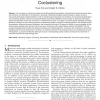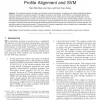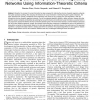TCBB
2008
15 years 26 days ago
2008
Under a stochastic model of molecular sequence evolution the probability of each possible pattern of characters is well defined. The Kimura's three-substitution-types (K3ST) m...
105
click to vote
TCBB
2008
15 years 26 days ago
2008
Reconstruction of phylogenetic trees is a fundamental problem in computational biology. While excellent heuristic methods are available for many variants of this problem, new adva...
126
click to vote
TCBB
2008
15 years 26 days ago
2008
It is a consensus in microarray analysis that identifying potential local patterns, characterized by coherent groups of genes and conditions, may shed light on the discovery of pre...
144
click to vote
TCBB
2008
15 years 26 days ago
2008
The subcellular locations of proteins are important functional annotations. An effective and reliable subcellular localization method is necessary for proteomics research. This pap...
119
Voted
TCBB
2008
15 years 26 days ago
2008
The problem of discovering novel motifs of binding sites is important to the understanding of gene regulatory networks. Motifs are generally represented by matrices (PWM or PSSM) o...
TCBB
2008
15 years 26 days ago
2008
Emerging microarray technologies allow affordable typing of very long genome sequences. A key challenge in analyzing of such huge amount of data is scalable and accurate computatio...
110
click to vote
TCBB
2008
15 years 26 days ago
2008
Recently, the concept of mutual information has been proposed for inferring the structure of genetic regulatory networks from gene expression profiling. After analyzing the limitat...
TCBB
2008
15 years 26 days ago
2008
The Nature Reserve Selection Problem is a problem that arises in the context of studying biodiversity conservation. Subject to budgetary constraints, the problem is to select a set...
127
click to vote
TCBB
2008
15 years 26 days ago
2008
Abstract-- Many statistical measures and algorithmic techniques have been proposed for studying residue coupling in protein families. Generally speaking, two residue positions are ...
116
click to vote
TCBB
2008
15 years 26 days ago
2008
The last several decades have witnessed a vast accumulation of biological data and data analysis. Many of these data sets represent only a small fraction of the system's behav...



